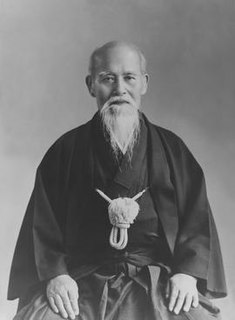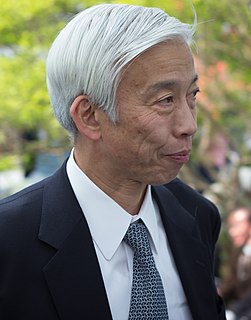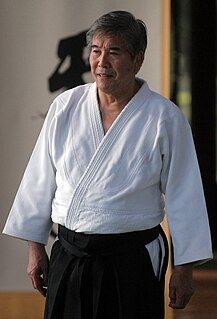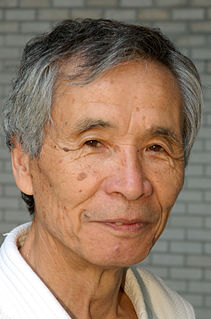Related Research Articles

Aikido is a modern Japanese martial art developed by Morihei Ueshiba, as a synthesis of his martial studies, philosophy and religious beliefs. Ueshiba's goal was to create an art that practitioners could use to defend themselves while also protecting their attackers from injury. Aikido is often translated as "the way of unifying (with) life energy" or as "the way of harmonious spirit". According to the founder's philosophy, the primary goal in the practice of aikido is to overcome oneself instead of cultivating violence or aggressiveness. Morihei Ueshiba used the phrase "masakatsu agatsu katsuhayabi" to refer to this principle.

Morihei Ueshiba was a Japanese martial artist and founder of the martial art of aikido. He is often referred to as "the founder" Kaiso (開祖) or Ōsensei (大先生/翁先生), "Great Teacher".

Moriteru Ueshiba is a Japanese master of aikido. He is a grandson of Morihei Ueshiba, founder of aikido, and son of Kisshomaru Ueshiba. Ueshiba is the third and current Doshu of the Aikikai.
Kisshomaru Ueshiba was a prominent Japanese master of aikido. He was the son of Morihei Ueshiba, founder of aikido, and became the international leader of aikido after his father's death.

Kenji Shimizu, b. 1940, is an aikido teacher and founder of the aikido style Tendo-ryu Aikido (天道流).

Christian Tissier is one of the best known European aikido teachers, who pioneered the art in France. He started his Aikido training in 1962 as a child in Jean-Claude Tavernier's Dojo in Paris, following the style of Hiroo Mochizuki. He soon went on to train under Mutsuro Nakazono and was awarded by him the 2nd dan before leaving for Tokyo in 1969. He came to the Aikikai Hombu Dojo as an 18-year-old, and trained there for seven years. Among the teachers that have inspired him are Seigo Yamaguchi, Kisaburo Osawa and the second doshu Kisshomaru Ueshiba. While living in Tokyo, he also trained in Kenjutsu under Minoru Inaba at the Shiseikan and in Kickboxing at the Mejiro Gym. He also worked as a model and taught French language at a school and Institut Franco-japonais de Tokyo.

Koichi Tohei was a 10th Dan aikidoka and founder of the Ki Society and its style of aikido, officially Shin Shin Toitsu Aikido, but commonly known as Ki-Aikido.
Gozo Shioda was a Japanese master of aikido who founded the Yoshinkan style of aikido. He was one of aikido founder Morihei Ueshiba's most senior students. Shioda held the rank of 10th dan in aikido.

Minoru Mochizuki was a Japanese martial artist who founded the dojo Yoseikan. He was a 10th dan in Aikido, 9th dan in jujutsu, 8th dan in iaido, 8th dan in judo, 8th dan in kobudo, 5th dan in kendo, 5th dan in karate, and a 5th dan in jojutsu.

Nobuyoshi Tamura was a prominent aikidoka and a direct student of Morihei Ueshiba. The son of a kendo teacher, Tamura entered the Aikikai Hombu Dojo in 1953 as an uchi-deshi of aikido founder Morihei Ueshiba. He was one of Ueshiba's favorite pupils and since 1964 has greatly contributed to the development of aikido in Europe and France in particular. He was the National Technical Director (DTN) of the FFAB. He held the rank of 8th dan and the title of Shihan. Throughout his teaching career he trained many others instructors in various countries around the world but foremost Western Europe. In 1999, he received the medal of "Chevalier de l'ordre National du Mérite" from the French government. Tamura published several books on aikido in French. His dojo, Shumeikan Dojo, is located in the village of Bras, France. His former students include Jorge Rojo Gutierrez, Toshiro Suga, Pierre Chassang and Alain Peyrache.
John Stevens is a Buddhist priest, teacher of Buddhist studies and Aikido teacher.
Masamichi Noro is the founder of Kinomichi and was an uchi-deshi of Morihei Ueshiba, the founder of Aikido.
Though the art of aikido is characteristically different from other Japanese martial arts, it has a variety of identifiable styles within the family of organizations descending from the teachings of Morihei Ueshiba.

A Byzantine–Mongol alliance occurred during the end of the 13th and the beginning of the 14th century between the Byzantine Empire and the Mongol Empire. Byzantium actually tried to maintain friendly relations with both the Golden Horde and the Ilkhanate realms, who were often at war with each other. The alliance involved numerous exchanges of presents, military collaboration and marital links, but dissolved in the middle of the 14th century.

Ma Fushou, a Hui, was the son of General Ma Qianling, and the brother of Ma Fucai, Ma Fulu, and Ma Fuxiang. He joined the martial arts hall and attended military school after three years of training in 1892.
Tsutomu Yukawa (湯川勉) (1911–1942) was a Japanese aikidoka.
Homma Gaku, born May 12, 1950, is an aikido teacher and direct student of the founder Morihei Ueshiba.
Futomani (太占) is a traditional Shinto system of divination. Practitioners attempt to foresee future events by interpreting the pattern of cracks made by heating the shoulder-blade of a stag. The practice is thought to predate the introduction of divination by tortoiseshell, which was imported from China; archaeological evidence suggests it originated as early as the Jōmon period.
Daichsun Tngri, also known as Dayisud Tngri and Dayičin Tngri, is a Mongolian war god "of a protective function" to whom captured enemies were sometimes sacrificed. One of the equestrian deities within the Mongolian pantheon of 99 tngri, Dayisun Tngri may appear as a mounted warrior. Some of his characteristics may be the result of the "syncretistic influence of Lamaism" ; the 5th Dalai Lama composed invocations to this deity.

Kenkoku University, or Jianguo in Chinese, was a short-lived university in Hsinking (Changchun), the capital of Manchukuo, the Japanese puppet state in occupied Manchuria during the Second Sino-Japanese War.
References
- 1 2 Sven Saaler; J. Victor Koschmann (9 January 2007). Pan-Asianism in Modern Japanese History: Colonialism, Regionalism and Borders. Routledge. pp. 60–62. ISBN 978-0-203-96546-7 . Retrieved 25 June 2013.
- ↑ Centre d'études mongoles et sibériennes (1976). Etudes Mongoles et Sibériennes 16. SEMS. p. 52. GGKEY:91AQDCGZSU6.
- ↑ Ann Heylen (1 January 2004). Chronique Du Toumet-Ortos: Looking Through the Lens of Joseph Van Oost, Missionary in Inner Mongolia (1915-1921). Leuven University Press. pp. 191–203. ISBN 978-90-5867-418-0 . Retrieved 25 June 2013.
- ↑ Stevens, John (1999). Invincible Warrior: A Pictorial Biography of Morihe Ueshiba, the Founder of Aikido. Boston, London: Shambhala. pp. 37–45. ISBN 9781570623943.
| This Chinese biographical article is a stub. You can help Wikipedia by expanding it. |